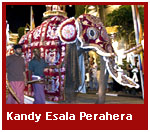|
 |
Other
Cities of Interest |

|
Colombo
Is the largest city and former administrative
capital of Sri Lanka. It is located on the west
coast of the island and adjacent to Sri Jayawardenepura
Kotte, the present administrative capital of the
country. Colombo is a busy and vibrant city with
a mixture of modern life and colonial buildings
and ruins. The Colombo Metropolitan Region, is
defined by the districts of Colombo, Gampaha and
Kalutara.
The name "Colombo", first introduced
by the Portuguese in 1505, is believed to be derived
from the classical Sinhalese name Kolon thota,
meaning "port on the river Kelani".
It has also been suggested that the name may have
derived from the Sinhalese name Kola-amba-thota
which means "Harbour with leafy mango trees".
Due to its large harbour and its strategic position
along the East-West sea trade routes, Colombo
was known to ancient traders 2,000 years ago.
However it was only made the capital of the island
when Sri Lanka was ceded to the British Empire
in 1815 and its status as capital was retained
when the nation became independent in 1948. In
1978, when administrative functions were moved
to Sri Jayawardenepura Kotte, Colombo was designated
as the commercial capital of Sri Lanka.
Like many cities, Colombo's urban area extends
well beyond the boundaries of a single local authority,
encompassing other Municipal and Urban Councils.
The main city is home to a majority of the Sri
Lanka's corporate offices, restaurants and entertainment
venues. Famous landmarks in Colombo include the
Galle Face Green, the Viharamahadevi Park and
places of attraction and interest are the Colombo
National Museum and the Natural History Museum,
Gangaramaya temple, Kelaniya temple, Old Dutch
church, Dutch period museum, Bandaranaike Memorial
International Conference Hall (BMICH) and it’s
museum, Old parliament complex, Art galleries,
the zoological garden and the buzzing bazzar area
of Pettah
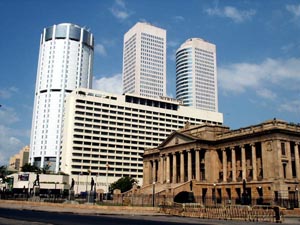
|
Haputale
Situated 193 km from Colombo on
the Colombo - Kandy - Nanu Oya (Close to Nuwara
Eliya ) - Badulla road & railway line sits
Haputale at an elevation of 1579 m (4736 ft).
This is one of the most spectacularly situated
of all Sri Lankan towns. It is perched on a ridge
top at the southern edge of the hill country with
bird's eye views in both directions. To the south
is the plains & coast. To the north is across
the jagged lines of hills which recede into the
distance towards the hill country. Arrival into
the town by car, you will find that the sudden
descent is startling. You would feel like the
car is about to go airborne over the cliff as
the sharp bend creates an optical illusion.
Haputale Gap is one of the most spectacular
views in the country and on a bright and cloudless
day, one could see the ocean as a bright blue
line in the distance, disclosing the stabbing
rays of the little lighthouse of Hambantota,
far south.The principal pleasure of a stay in
Haputale is the chance to get out & walk
in the surrounding hills-most notably up to
(or down from) the magnificent viewpoint at
Lipton's Seat. Specific sights around town include
the tea factory at Dambatenne, the evocative
old county mansion of Addhisham a Benedictine
monastery and former home of Sir Thomas Villiers
designed in the Tudor style, on the lines of
Leeds Castle in Kent, The garden is home to
blue magpies, paradise flycatchers, green barbets,
brilliant orange plumaged hornbills, golden
orioles & a host of other bird life. St.
Andrew's, neo-Gothic Church nineteenth century
tea planters, along with the grave of Reverend
Walter Stanley Senior (1876-1938), author of
the once-famous “Ode to Lanka”,
Victorian Ceylon's great contribution to world
literature.& the impressive Diyaluma Falls.
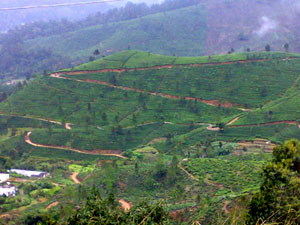
|
Kataragama
Kataragama is a place of great religious and cultural
interest, where devotees of the country’s
three major religions meet – Hinduism, Buddhism
and Islam. People from different religions come
here to worship in their own way, either in the
ancient shrines themselves or in their own places
of worship, For the Hindus
Katirkamam as Hindu’s call this place, is
revered as a sacred Hindu pilgrimage site, famous
for its fire walkers and water cutting ceremonies
during the predominantly Hindu Festival in July
and August. To participate in the festival, pilgrims
walk from as far as the Jaffna peninsula in the
north of Sri Lanka in the two-month “pada
yatra” or foot pilgrimage. Although Katirkamam
is normally a quiet and serene place, during the
festival it is a place where devotees practice
extreme acts of mortification of the flesh and
infliction of physical pain.
Buddhists believe Kataragama is one of the 16
principal places of Buddhist pilgrimage in Sri
Lanka. Buddha is said to have visited Kataragama
and meditated there to sanctify the place. King
Mahasena met the Lord Buddha there and listened
to Buddha’s discourse. As a token of gratitude
the Dagoba was built on the exact spot where Buddha
sat.
The sanctity attached to the place by local
Muslims revolves around a mysterious being called
al-Khidr or 'The Green One'. Muslim commentators
are not agreed on exactly who he was. Some say
he is a prophet while others say he is a “wali”
meaning one who is close to God, in other words,
a saint. His presence is believed to pervade
the sanctuary with which he is associated, namely,
the Khalir Makam in the Muslim quarter of Kataragama
not far from the Menik Ganga (the river). Indeed,
there are those who believe that it was this
Khidr who gave his name to Kataragama.
without a trace of rivalry or animosity. It
is truly a unique place in the world today.
Apart from the festival time, Kataragama is
busiest with pilgrims at weekends and on full
moon poya days
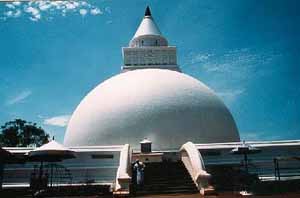
|
Nuwara
Eliya
The town was founded by Samuel Baker as a hill
retreat for the British during the colonial era,
where typical English pastimes including fox hunting,
polo and cricket were played. Many of the buildings
retain features from the colonial period, and
even new hotels are often built and furnished
in the colonial style. Due to the high altitude,
Nuwara Eliya has a much cooler climate than the
lowlands of Sri Lanka, with annual temperatures
running at 16 °C. and sometimes dropping to
as low as 3°C. In the winter months it is
quite cold at night, and there can even be frost,
but there has been no record of snow, although
it rapidly warms up as the tropical sun climbs
higher during the day. The town really comes alive
during the month of April for the Sinhalese and
Tamil New Year, and it becomes quite difficult
to find accommodation if not booked well in advance
as the Sri Lankan holiday makers make way to this
region during this period. The festive season
starts on April 1st annually in a ceremonial manner.
The ceremony consists mainly of a band show in
which all the local school bands participate.
Main attractions during April season include the
numerous motor racing and horse racing events.
and the flower show at the end of the month. The
town's attractions include the golf course, trout
streams, Victoria Park, and boating or fishing
on Lake Gregory. Victoria Park is an attractive
and well-used oasis. It is popular with birdwatchers
The town is a base for visits to Horton Plains
National Park. This is a key wildlife area of
open grassy woodland. Species found here include
the Leopard, Sambar, and the endemic Purple-faced
Langur. Endemic highland birds include the Dull-blue
Flycatcher, Sri Lanka White-eye, and Yellow-eared
Bulbul. The plains also has a well-visited tourist
attraction at World's End, a sheer precipice with
a 1050 m drop. The return walk passes the scenic
Baker Falls. Early morning visits are best, both
to see the wildlife, and to view World's End before
mists close in during the later part of the morning.
One of the distinctive features of Nuwara Eliya's
countryside is the widespread growing of vegetables,
fruit and flowers usually associated with temperate
Europe. This town also known as "Little England"
due to it’s typical charecteristics is covered
with terraces growing potatoes, carrots, leeks,
and roses, interspersed with tea bushes on the
steeper slopes. The slow-growing tea bushes of
this highland region produce some of the world's
finest Orange Pekoe tea, and several tea factories
around Nuwara Eliya offer guided tours and the
opportunity to sample or purchase their products.
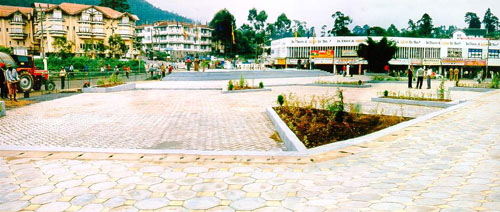
|
Ratnapura
Ratnapura (City of Gems) is the name of the provincial
capital of Sabaragamuwa Province of Sri Lanka
and the Ratnapura District in which the town is
situated, some101 km south east of Colombo. The
name is derived from the Sinhala word "ratna"
meaning gems and "pura" meaning city
as it is the centre of a long-established industry
of precious stone mining including rubies, sapphires,
and other precious and semi precious stones. Legendry
gems like the Blue sapphire called ‘Blue
Belle’ which adorns the Royal British Crown
and the Star sapphire inappropriately named ‘Star
of India’ which is on display at The Museum
of Natural History in New York have been excavated
from Sri Lankan Gem mines. Gem pits are a common
site in the surrounding area. Most of the gem
businessmen operate from Ratnapura. There are
also a few numbers of foreign gem traders too.
Traders from suburbs and other towns gather daily
in the town centre to sell or buy gemstones. Large-scale
merchants collect gemstones from locals and sell
them in the International markets. There is also
a Gem Museum where one can get familiarized with
the gem cutting process etc. Apart from gem mining,
the town is known for rice and fruit cultivations.
Large plantations of tea and rubber surround the
town. Tea grown in this region is called low-country
tea. There are quite a few places of worship in
this area but apart from Adams Peak the most important
to Buddhist devotees would be the Maha Saman Devala
This is a shrine dedicated to the god Saman, a
deity considered to be the guardian of Ratnapura.
History has it that when the Portuguese captured
Ratnapura, the ancient shrine that stood at this
location was destroyed and a Portuguese church
was constructed on top of it. Subsequently when
the Kandyan kings recaptured Ratnapura, the Portuguese
church was destroyed and the shrine was rebuilt.
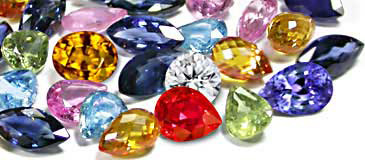
|
Trincomalee
Trincomalee is a district, a bay and a port city
on the northeast coast of Sri Lanka about 185
km northeast of Kandy. The town is built on a
peninsula, which divides the inner and outer harbours.
It is one of the main centers of Tamil speaking
culture on the island. It has been a sea port
that has played a major role in maritime and International
trading history of Sri Lanka.
The Bay of Trincomalee's harbour is renowned for
its large size and security and is a natural deep-water
harbour. Trinco, as it is commonly called, has
been a sea port since the days of the ancient
Sri Lankan Kings and has attracted sea farers
like Marco Polo, Ptolemy and Sea Traders from
China and East Asia since ancient times and was
the first land to be captured by the British who
fought and defeated the Dutch. During the second
world war the harbour was used as a base for the
combined East Asian Fleet of the Allied forces.
Unlike every other in the Indian Sea, it is accessible
to all types of craft in all weathers and was
described by Admiral Lord Nelson as the finest
harbour in the world when he visited it aboard
HMS Seashore in the year1770. Today during the
months of April to November the beaches particularly
Nilaveli 6km further north of Trinco is popularly
used for surfing, scuba diving. Fishing and Whale
watching is also popular in Trinco. The town also
has the largest Dutch fort in Sri Lanka. And is
home to major Sri Lankan Naval bases and a Sri
Lanka Air Force base. Apart from the harbour Trincomalee’s
next focal point is Fort Frederick, named after
Fredrick the great. British fortifications can
still be found here.
The seven hot springs of Kanniya located approximately
11km west of Trincomalee is also a popular attraction.
A high wall bounds the rectangular enclosure which
includes all seven springs. Each is in turn enclosed
by a dwarf wall to form a well. The water is warm,
the temperature of each spring being slightly
different. The use of the springs for bathing
is controlled by the neighbouring Mari Amman Kovil,
who holds the lease of the wells, it is scared
to Hindus who believe them to be a creation of
God Vishnu.
Other attractions in the area is the Thirukoneswaram
Kovil which stands on the top most pinnacle of
the Swamy Rock which is a high venerated Hindu
shrine dedicated to Lord Shiva.A visit to the
nearby Pigeon Island by boat is also a common
interest among visitors.
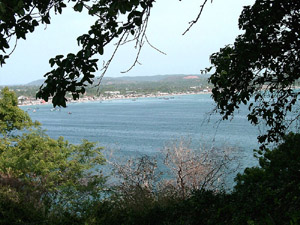
|
|
|
|
|
|
 |





